|
|
|
|
|
Western Digital Raptor 10k-RPM HDD |
|
Join the community - in the OCAU Forums!
|
Introduction, Detail, How we Tested
THE FIRST OF ITS KIND
The change from hard disk drives with 5,400 rpm rotational speed to 7,200 rpm some years ago substantially improved performance. 5,400 rpm disks are these days only used for entry level systems. Itís also apparent that the rotational speed is more significant for disk performance than the much talked about interface. Even an ATA 133 interface that allows for a peak transfer rate of 133 MB/sec is meaningless when most hard disk drives today do not even deliver an average transfer speed of 40 MB/sec. Why then havenít we seen the next step from 7,200 to 10,000 rpm disks in the many years since the introduction of HDD with 7,200 rotational speed? We know that mechanically such a speed is no problem at all, as SCSI disk drives with platter speeds as high as 15,000 rpm have been available for some time. The reason why ATA equivalents of such drives were not available until now is of a commercial nature: most manufacturers are enjoying a much better profit margin with their high cost SCSI disks. They certainly donít like the idea of reducing this business by releasing ATA disks with similar performance but lower prices and smaller profit margins. The US manufacturer Western Digital on the other hand is not manufacturing SCSI disks and therefore it makes sense that it is Western Digital which brings now the first 10,000 rpm IDE disk into the market: the WD360GB with the fancy marketing name Raptor.
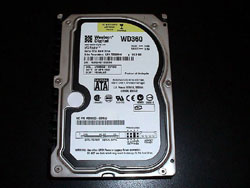
High-end desktop users have been waiting for a 10,000 rpm hard disk for a long time. SCSI disks are out of reach for many due to the higher cost - both for the drive itself and for the necessary SCSI controller. Together with an 8 MB disk cache size, another innovation brought into the IDE disk market by Western Digital, the RAPTOR looks quite intriguing for power users. The SATA 150 interface is an additional bonus because of the slim cables and the lower power consumption, but by itself does not enhance performance. The SATA interface is widening the gate for a transfer rate of up 150 MB/sec in comparison to the 100 or 133 MB/sec newer parallel ATA disks offer. But as already mentioned, not even the best HDD comes even remotely close to such a high transfer rate.
Western Digital is marketing the Raptor for the enterprise level, meaning servers and workstations. But certainly this disk is also interesting for high-end desktop systems and enthusiasts. We are testing the Raptor here with the high-end desktop user in mind. The first part of our test will bench the Raptor as single disk and compare it with 7,200 rpm ATA 100 and ATA 133 disks. In a future second part of this article, we will report test results with the Raptor in RAID 0x2 and RAID 0x4 configuration.
THE RAPTOR IN DETAIL
The first thing the user is realizing with the Raptor is the heavier weight and the slightly different housing design. A 10,000 rpm spindle speed is naturally producing additional heat and vibration. At 730 gram the Raptor is noticeably heavier than 7,200 rpm disks because the housing is more massive and rugged on one side for improved rigidity and heat dissipation.
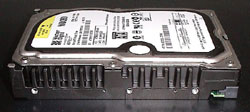 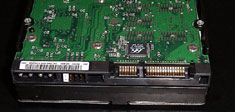
The Raptor has, as with all current SATA drives, 2 power plugs: the new SATA connector as well as a legacy Molex power connector. The reason for the new connector is the lower power consumption of SATA disks. Newer ATX Power Supplies are already coming with SATA connectors replacing some of the obsolete Molex connectors. But nobody with an older PSU has to worry: Molex connectors work without any problem with the Raptor. The usual jumper settings for cable select etc are missing because a SATA disk can only run as a single disk. The Raptor has only a jumper setting to enable Power Management. The disk PCB is facing inwards. Only the Parallel to Serial ATA Bridge Marvell 88i8030-TBC chip is visible.
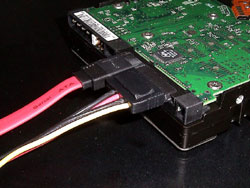 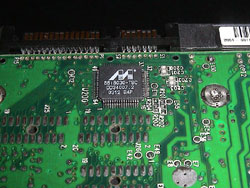
HOW WE TESTED
We tested the Raptor from the 2 controller types that can currently control a SATA disk: the Southbridge controller and a RAID controller:- from the Intel ICH5-R Southbridge implemented together with new 865/875 chipsets
- from the Silicon Image SiL3122A SATA RAID controller
The new Intel 875P based boards come all with native SATA support through the Intel ICH5 Southbridge. But for older boards without native SATA support through the Southbridge, like Intel 845PE or nForce 2 based boards, the only way to run a SATA disk is from such a RAID controller like the SiL3122. We therefore are testing the Raptor here from both controllers.
The ICH5 is the first Southbridge with integrated SATA support. Intel is offering the ICH5 in 2 versions, with (ICH5-R) and without (ICH5) integrated Raid 0 support. The ICH5 has 2 channels, which are shared on most boards between 2 SATA and 2 PATA ports. The ICH5-R allows additionally to combine the 2 channels to a RAID 0 array when using SATA disks. Why is native SATA important? Initially SATA was provided only by RAID controllers using the PCI bus. This bus however is limited to a peak bandwidth of 133/MB/sec whereas the current SATA interface is good for 150 MB/sec. When running a single SATA disk from such a controller the PCI limitation does not constitute a problem because not even the burst speed of current IDE HDD comes close to 150 MB, and the sustained transfer rates are not even half of this. But when using 2 SATA disks in RAID 0 which can result in a transfer speed of 100 MB/sec or more the PCI bus could become saturated when it is used at the same time by other PCI device like LAN or sound cards. The 2 independent ICH5-R IDE channels are providing a combined maximum bandwidth of 300 MB/sec. The limitation here is the ICH (Southbridge) to MCH (Northbridge) connection with a maximum of only 266 MB/sec. This is apparently less than the combined 300 MB/sec peak bandwidth the 2 ICH5-R SATA channels in theory can handle, but itís still double as much as the current PCI bus can offer when it would be used for nothing else than HDD data transfer.
We used the Gigabyte GA-8KNXP motherboard for our test. This board is based on the Intel 875P (Canterwood) chipset and is sporting the Intel ICH5-R Southbridge, the SiL3122A SATA RAID controller, and an additional PATA RAID controller. The 8KNXP was the perfect test platform for our tests. The existing 4 SATA channels will let us later, in the second part of this article, test the RAPTOR not only in RAID 0x2 but also in RAID 0x4 using the Windows XP Dynamic Disk function.
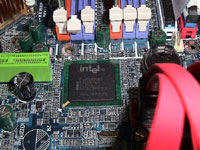 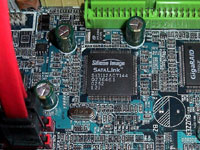 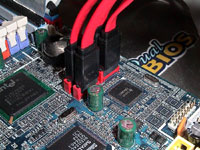
We compared the Western Digital Raptor with 2 mainstream parallel ATA disks, the ATA 133 Maxtor D740X and the STA 100 Hitachi 120GXP. In both cases we used the 1 platter 40 GB varieties of these models. We have tested both disks before (see here) and found them well performing with a clear advantage for the IBM/Hitachi 120 GXP. The comparison with these 7,200 rpm ATA 100 and ATA 133 HDD with the 10,000 SATA Raptor will let us see whether the latest state-of-the-art HDD technology combining SATA 150, a 8 MB buffer size and a 10,000 rpm spindle rotational speed offers a perceivable performance advantage.
|
|
Advertisement:
All original content copyright James Rolfe.
All rights reserved. No reproduction allowed without written permission.
Interested in advertising on OCAU? Contact us for info.
|

|


